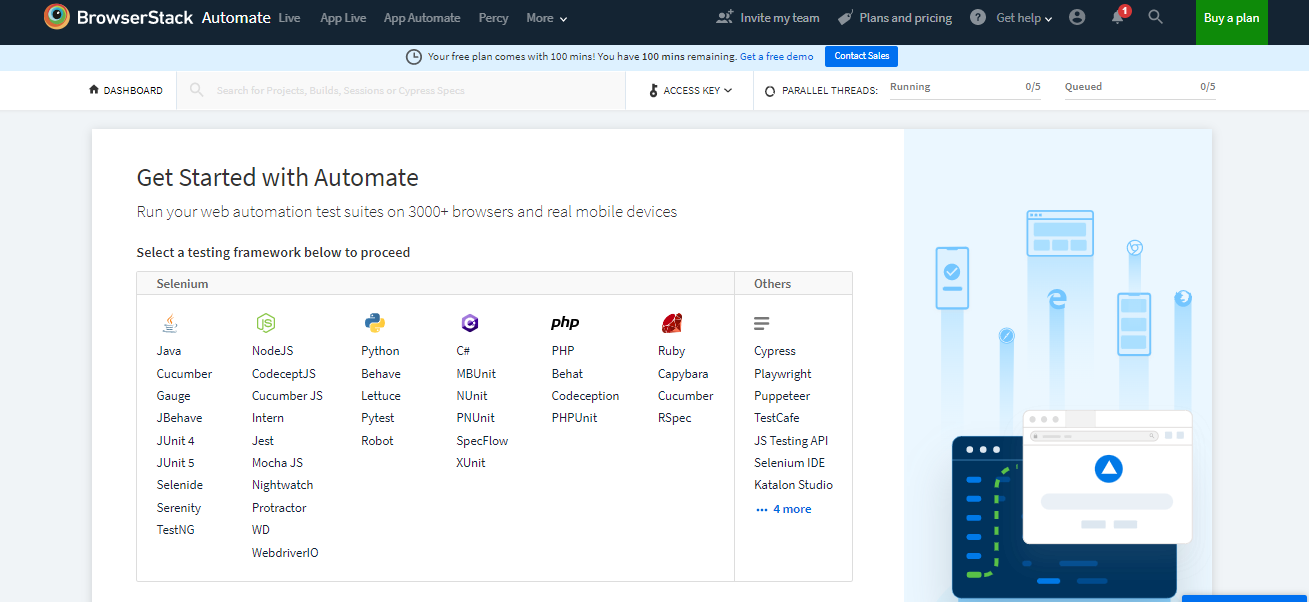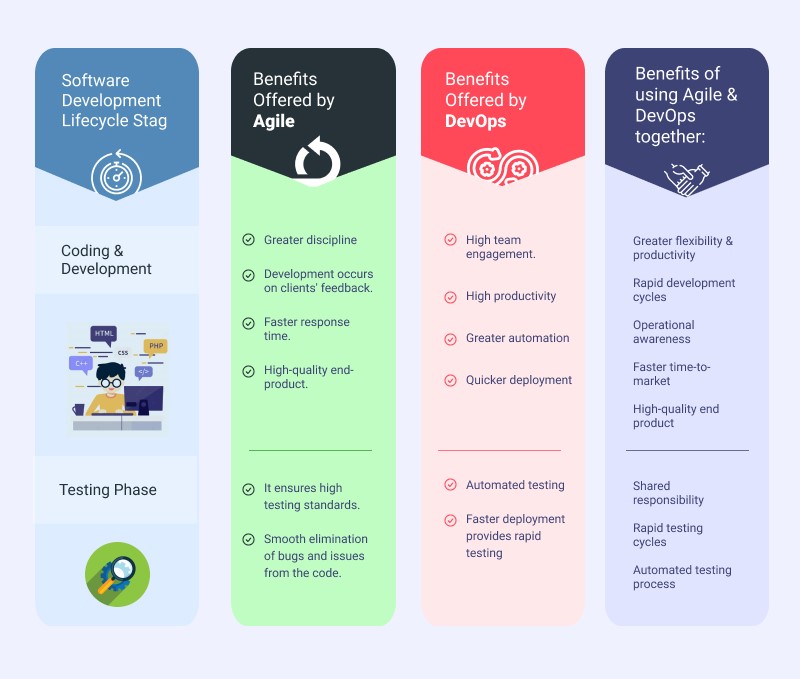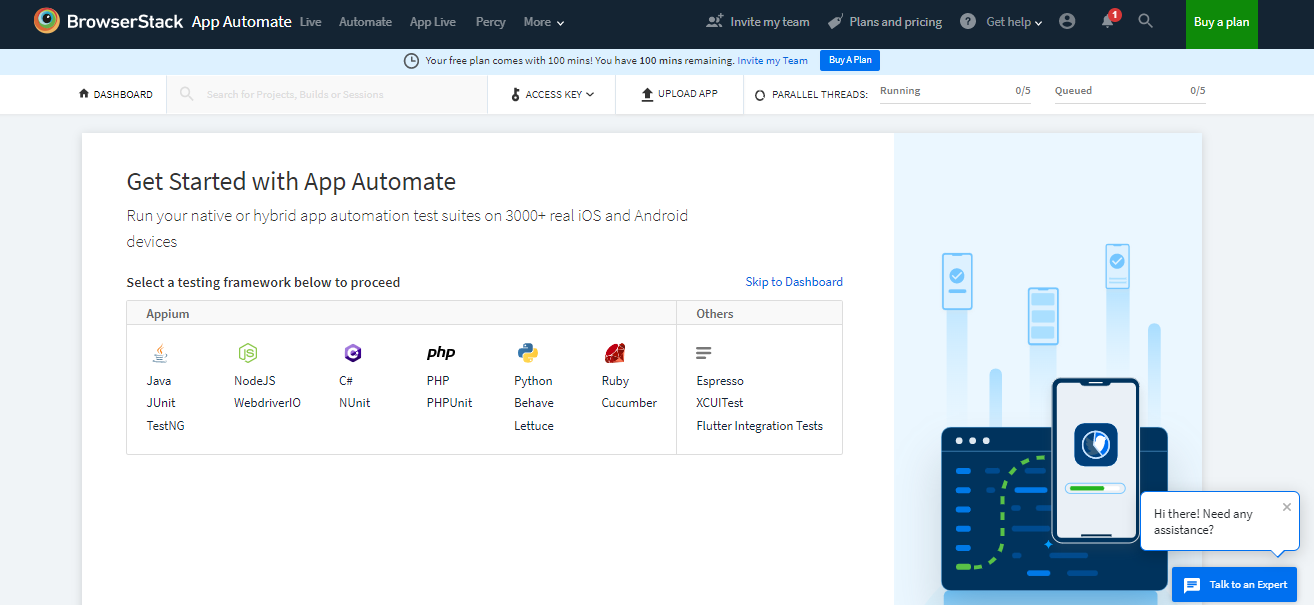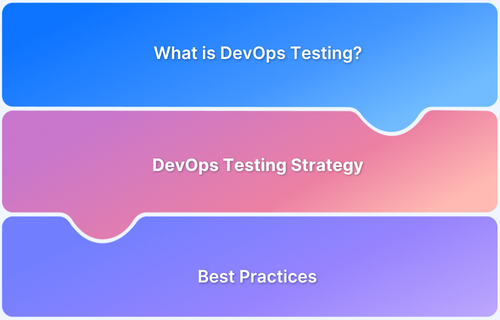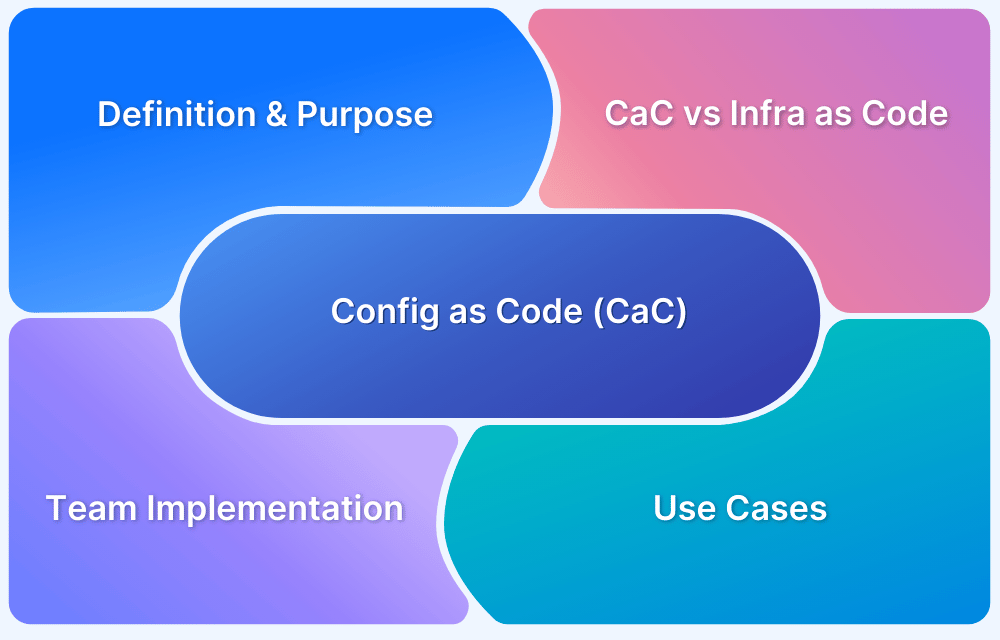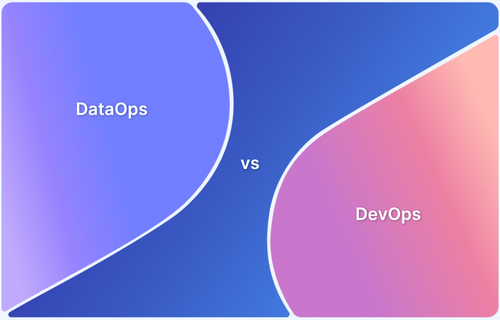Agile and DevOps are distinct but complementary approaches that strengthen modern software delivery. Agile focuses on iterative development, while DevOps streamlines deployment and operations. When combined, they enable faster releases, fewer bugs, and minimal downtime, efficiently meeting market demands.
They empower QA and tech teams to manage software inconsistencies and outages more effectively.
Overview
- Agile is an iterative software development approach focused on collaboration, flexibility, and rapid delivery.
- DevOps is a set of practices that integrates development and operations to automate and streamline software delivery.
How Agile and DevOps Interrelate?
- Automation Testing: Enables fast, reliable validation for Agile sprints.
- Continuous Integration: Supports frequent Agile code updates with smooth builds.
- Modular Design: Fits Agile iterations and DevOps deployment flows.
- Development Flow: Agile drives speed; DevOps ensures delivery.
- Feedback Cycles: DevOps speeds up feedback for Agile improvements.
This guide explains how these two relate, whether DevOps is a subset of Agile, or if they operate independently.
What is Agile?
Rather than a linear progression towards product deployment/ delivery, the agile method focuses on the continuous iteration of development and testing during the SDLC. This approach to software development concentrates on iterative and incremental growth. As the Agile approach splits production into concurrently running projects, the stage to final delivery is reduced. When every single piece of the project is complete, it’s all brought together for QA tests.
- Agile methodology is more than a step-by-step procedure; it is a complete philosophy that targets to add value to the clientele with greater ease.
- The project’s plans, requirements, and outcomes are constantly re-evaluated.
- This creates a speedy pace, with higher accuracy and the capacity to respond rapidly to new info and circumstances.
- To accomplish this, Agile teams practice a range of techniques, including pair programming, sprints, stand-ups, planning sessions, & test-driven developments.
Popular Agile Technologies used
An agile team will comprise plentiful product development roles and responsibilities that support the complete direction of a project. The Product Owner signifies the stakeholders & upholds the extended project vision. In support of that assignment, investors, clients, and business executives will aid in addressing issues within the development life-cycle.
Because of the high level of coordination required for complex projects with concurrent work necessities, service providers prefer agile development tools. Most technologies fit within known project management frameworks like Kanban or Scrum.
Key Agile tools comprise:
- GitHub: The code hosting platform
- JIRA: Issue tracking and work management software
- Active Collab: Project management results with digital communication apps
- Planbox: An advanced modular platform for lifecycle competence
There are also a few Agile testing challenges such as
- Performance Bottlenecks
- Early Detection of Defects
- QA Wait Time
- Insufficient Test Coverage
- Changing Requirements
- Slow Feedback Loop
- Deferring or Skipping Essential Tests
- QA Tester’s Accessibility
- Different Devices/ Browsers (Device Fragmentation)
You can overcome such agile challenges by testing on BrowserStack. Attain ease in automation, tests in cross devices, and cross-browser and practical visual tests for your site.
What is DevOps?
DevOps is the blend and amalgamation of two varied teams; operations and development. The incorporation of these two competent teams generates effective and efficient software development. Cooperation is the name when it comes to DevOps.
Rather than having these two departments working distinctly, companies can enhance communication, collaboration, and integration amongst their IT teams with a DevOps software development technique. When DevOps is successfully implemented, companies can expect speedy deployment, a higher number of deployments, lower change failure rates, and a noteworthy increase in incident recovery.
Popular DevOps Technologies used
DevOps methodology mainly favors cross-functional teams with definite roles that manage every single facet of a product build.
The accurate technology enables teams to capture the advantages of the DevOps methodology. DevOps tools can assist with implementation, and distinct service providers proffer tools that support the collaboration and automation of the DevOps product lifecycle:
- JIRA: Tracking software for errors/ bugs
- Maven: Automated tools for Java projects
- Jenkins: Automated tools that assist continuous integration
- Git: Software tools to track modifications to source code
- Bitbucket: Source code repository for CI/CD optimization
Given the significance of DevOps to advanced software development, BrowserStack’s real device cloud has been designed to align with DevOps-driven workflows. Integrations with popular CI/CD tools – Travis CI, GitLab, Jenkins, Bamboo, TeamCity, Circle CI, and Azure Pipelines makes it a breeze for DevOps teams
Then there are integrations designed to facilitate test automation for apps and websites– Espresso, Appium, XCUITest, Puppeteer, and Playwright.
Must-Read: Why DevOps Teams need Cloud-Based Solutions
Common Myths about Agile and DevOps
One of the most common myths about DevOps and Agile is folks often consider that they are synonyms which isn’t true at all. Many ponder the question, “How does Agile and DevOps interrelate ?”
When used collectively, DevOps and Agile can be used together to generate flawless software promptly. Another common myth is that DevOps and Agile terms can be utilized interchangeably. While both practices contribute to effective software deployment, Agile is an operational methodology, while DevOps refers to the integration of the Operations and Development team.
One of the core reasons behind this misconception is that DevOps and Agile are used together to reorganize and improve development and business operations and accelerate product delivery. However, the way they function, the key methodologies, and the concepts are fully diverse from one another.
- Agile methodology can be defined as an operational method that divides an intricate and lengthy process into numerous simpler and smaller elements for the respective teams/employees to implement quickly and easily.
- DevOps, on the flip side, is a collaborative approach to expedite better contribution and communication of IT and development teams.
- While Agile simplifies complex workflows and tasks, DevOps assists in ensuring better communication, transparency, and efficiency for any business.
How do Agile and DevOps Interrelate?
One common misconception is that Agile and DevOps can’t work together. This misconception unpleasantly affects everybody involved in the software development and delivery arena. Both these approaches can significantly add to the Scrum pillars of transparency, adaption, and inspection to efficiently allow product teams to arrange, deliver and uphold intricate products.
Both Agile and DevOps exemplify powerful ideas that can add value to the team’s workflow. The amalgamation ensures the success of the business.
- Even though Agile and DevOps fluctuate in their approach, they both have similar objectives: effectual software development and accelerated product releases.
- DevOps can fit within each stage of a product’s lifecycle, setting upon the manageable jobs outlined by agile.
- Agile relies on company values, whereas DevOps relies on workflow over the delivery pipeline. Collectively, the two approaches enhance development.
Outside the cultural mindset, both philosophies provide, there is a significant interrelation between agile and DevOps.
Automation Testing
Both DevOps and Agile test, but in complementary ways. Agile uses specific skills from individuals to form standards to test that guarantee quality. On the other side, DevOps automates recurring testing and builds in compliance with product deployments. Together, high-end testing happens as all persons shoulder the duty of quality assurance (QA).
Learn More: Role of Automation Testing in CI/CD
Continuous Integration
Both Agile & DevOps depend on CI (continuous integration) and CD (continuous delivery) to improve the product delivery lifecycle. Agile leverages small portions of work that integrate into a cohesive whole, whereas DevOps automates code integrations to accelerate release deployments as per the business requirement. Together, they make a reliable, safe, and effective pipeline.
Modular Design
Agile utilizes design principles that are reusable and modular, generating environments that promote research and experimentation. Similarly, modular components like Git containers or repositories help execute agile principles at scale.
Read More: DataOps vs DevOps: Key Differences
Development Flow
Both methodologies support management. Agile sets the phase for learning, skills development, and team input, whereas DevOps automates each operations task to enhance responsibility and collaboration amongst dev teams. Together, team goals are accomplished with a perfect project and management flow.
Feedback Cycles
Both DevOps and Agile emphasize flexibility and adaptability. Agile utilizes Scrum and sprints as management procedures, which comprise fast feedback from all stakeholders. Whereas DevOps supports such responses by automating & flagging failures. Collectively, the product quality enhances according to user expectations.
Read More: DevOps vs Scrum
Why use Agile and DevOps Together? (Benefits)
Combining Agile and DevOps operations aid in launching the software on time; it lets teams build apps during the right time, promotes productivity, and improves efficiency, among the developers. And what would be the anticipated rewards of interrelating DevOps and Agile? Of course, companies do necessitate more than just connections between teams.
There are substantial benefits to combining the two techniques.
- It encourages automation: Both these technologies introduce automation into the workflows, allowing QA teams to automate most of their everyday actions. Some jobs one can automate comprise fixing bugs, code reviewing and scanning, etc. It will give the QA team extra time to focus on other facets of development.
Integrating DevOps and Agile results in quality products that enhance users’ satisfaction. It also makes the software development procedures have slight bugs and is simple to fix. It also makes the procedures have lesser threats because the processes streamline how to launch the software, making teamwork easy.
- Measurement: Combining these two methodologies makes tracking project updates and progress simple. The QA team takes varied measures to ensure successful application deployment. Other activities measure the time from software development to deployment, examining the platform’s necessities and the amount used in a launch.
- It enhances Teamwork: The teamwork makes it simple to meet the business’s worth and gives distinct shapes to the software development jobs.
Both methods are crucial in the app and software development processes. Both depend on each other; yet building & successful operations take time. They support speedy app development that gives quality products when you know how to utilize both. However, one of the major roadblocks to developers and testers working together remains the “unreplicable bug”.
BrowserStack provides real-time devices for mobile application testing and automated app testing. Simply upload the application to the required device-OS combo & check to notice how it functions in the real-time world.
Conclusion
The two approaches are distinct in several ways. The two came into existence owing to an alteration in software development patterns. Both methodologies function towards developing software rapidly and without the downtime and customer dissatisfaction. But, lack of knowledge leaves organizations wondering how DevOps and agile interrelate. And the answer to the query is that both go in line simultaneously, and their interrelation results in satisfied users and high business growth.


